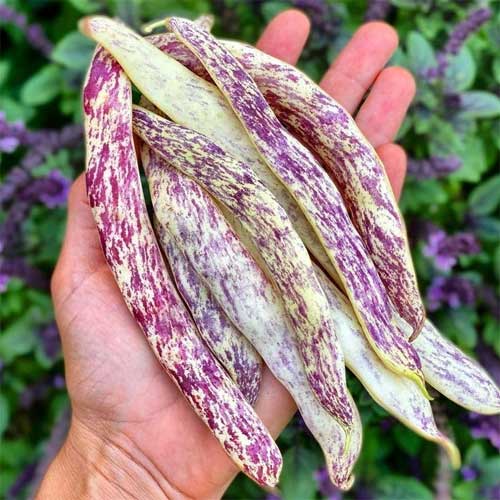Total Number of seeds: 15
Dragon Tongue Beans Seeds 🌱
Dragon Tongue Beans Seeds are a unique heirloom variety known for their beautiful cream-colored pods streaked with purple. These beans are perfect for gardeners looking for a high-yielding, visually striking crop that thrives in warm climates. The beans have a sweet, nutty flavor, and the pods are versatile for many cooking styles, from steaming to stir-fries.Dragon Tongue Beans Seeds
About This Item
- Type of Seeds: Heirloom, Open Pollinated
- Germination Time: 7-10 days
- Hours of Sunlight: Requires full sunlight, 6-8 hours daily
- Where to Grow: Ideal for garden beds, raised beds, or large containers
- Growing Season: Early summer or post-monsoon
- Seeds Sowing Depth: 1-2 inches deep
- Ideal Climate: Warm, temperate climates
- Plant Height: Bush variety, around 1-1.5 feet tall
- Organic Fertilizer Requirement: Apply compost or organic fertilizer at planting and during growth
- Life Span: Annual
- Ideal Growing Temperature: 18-26°C
- Harvesting Time: 60-70 days after planting
- Maintenance Required: Low; occasional weeding and watering
- Watering Frequency: Regular, ensuring soil stays moist but not waterlogged
- Ideal Grow Bag Size: Use a grow bag that is 12-15 inches wide and deep


What size grow bag is best for Beans?
Growing Season in India
In India, Dragon Tongue Beans grow best during early summer or after the monsoon. The beans thrive in well-drained loamy soil with a pH between 6.0-7.5, receiving ample sunlight for healthy growth.
How to Grow in Pots
- Choose a 12-15 inch pot with drainage holes.
- Fill with well-drained, loamy soil mixed with compost.
- Plant the seeds 1-2 inches deep and space them about 6 inches apart.
- Place the pot in a sunny spot where it gets 6-8 hours of sunlight a day.
- Water the plants regularly, keeping the soil moist but not waterlogged.
- Beans will be ready for harvesting in 60-70 days.
Seeds Sowing Method
- Preparation: Prepare well-drained soil rich in organic matter.
- Sowing: Sow seeds 1-2 inches deep and space them 6-8 inches apart.
- Watering: Keep the soil consistently moist, especially during dry periods.
- Germination: Expect germination within 7-10 days in warm, sunny conditions.
- Transplanting: Dragon Tongue Beans are bush varieties, so no transplanting is needed. They can be directly sown into their final growing location.
Plant Care Tips For Dragon Tongue Beans Seeds
- Ensure the plants get plenty of sunlight, around 6-8 hours daily.
- Water regularly to keep the soil moist but not soggy.
- Use organic fertilizer or compost every few weeks for healthier plants.
- Weeding around the base of the plants will help prevent competition for nutrients.
How to Fertilize Vegetable Plants Effectively
1. Apply Nutrient-Rich Fertilizers
When your plants begin flowering, use nutrient-rich fertilizers like Organic Bone Meal Powder or Vermicompost. This helps in boosting the bloom and enhances overall yield.
2. Use Organic Fertilizers
Feed your plants with organic fertilizers such as Cow Dung Manure or Neem Cake. Organic options promote healthy soil life.
3. Regular Feeding
Apply fertilizers every 20-25 days to ensure plants receive a steady supply of nutrients. Choose from various options like Cocopeat Compost for moisture retention.
Special Features
Dragon Tongue Beans are eye-catching with their purple-streaked pods and are highly versatile in the kitchen. They are perfect for use in salads, stir-fries, or steaming. These beans also offer a high yield, making them a rewarding crop for home gardeners.
Benefits/Uses
Dragon Tongue Beans are perfect for steaming, sautéing, and adding to salads. They retain their flavor and texture when cooked, and the pods can be enjoyed fresh or lightly cooked. They are also great for pickling or freezing for later use.
Precautions While Growing
- Avoid waterlogging the soil to prevent root rot.
- Ensure proper plant spacing to promote healthy air circulation.
- Harvest beans regularly to encourage continued production.
Common Problems Affecting Plants and Solutions
- Pests: Neem oil can be used to control pests like aphids and beetles.
- Fungal Issues: Ensure good airflow between plants to prevent fungal infections.
- Watering: Keep the soil consistently moist but avoid overwatering, which can cause root rot.


Divya K
Leaf colour remained bright and healthy.
Shilpa T
Beej ki quality strong thi, germination smooth hua.
Imran V
The plants adapted well after transplanting.
Rahul I
Seedlings strong bane aur development steady tha.
Soumya T
Beans plants ne early stage se hi strong growth dikhayi.
Nandita M
Growth kaafi smooth rahi, plants fresh dikh rahe hain.
Sameer K
The plants adapted well after transplanting.
Lekshmi A
The seedlings developed strong stems.
Firoz M
The seeds sprouted well and developed strong seedlings.
Gopal Raj
Beej ki quality badhiya lagi.